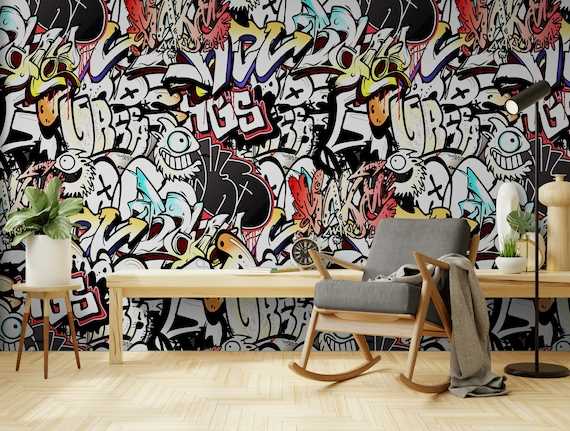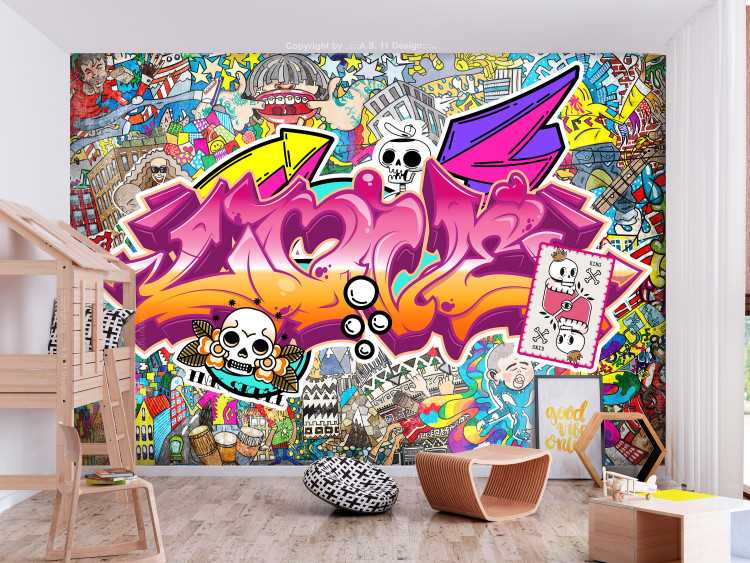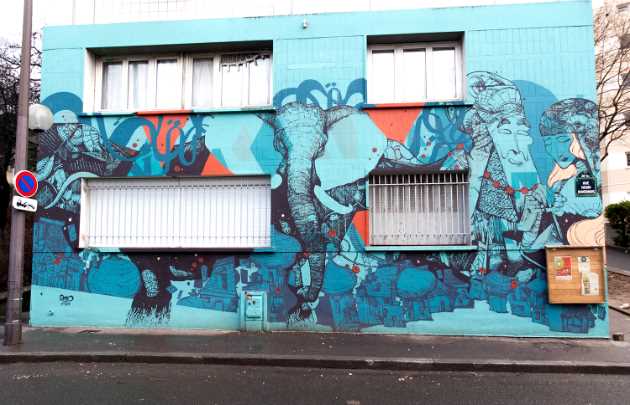The concrete walls of urban buildings are transformed into vibrant works of art through the medium of mural painting. These larger-than-life images serve as a testament to the creativity and talent of local artists, while bringing beauty and color to the once dull and monotonous cityscape. Urban mural paintings have become an essential part of modern street art and are often embraced as a means of beautifying neighborhoods and fostering a sense of community.
From bustling metropolises to quiet towns, mural images have found their place in various locations around the world. Each mural tells a unique story, conveying different messages and evoking different emotions. Some murals pay homage to historical events, featuring important figures and scenes from the past. Others explore contemporary themes, shedding light on pressing social issues and encouraging viewers to reflect on the world around them.
What sets mural images apart from traditional paintings is their scale and public visibility. Whereas galleries and museums typically confine artwork, murals have the power to captivate and engage a wide audience. Passersby are drawn to these larger-than-life creations, often stopping to admire and contemplate the intricate details and vibrant colors that grace the walls. The accessibility of mural images allows art to transcend its usual barriers, reaching people who might not otherwise have the opportunity to experience or appreciate it.
Whether they are the product of local artists, renowned street artists, or community initiatives, mural images have the ability to transform urban spaces into open-air art galleries. Through their presence, these colorful paintings on walls not only inspire and provoke thought, but also foster a sense of pride and identity within the communities they adorn. They serve as a reminder of the beauty that can be found in unexpected places and encourage us to view our surroundings with a renewed sense of appreciation and wonder.
The History of Murals

Murals have a long and rich history, dating back thousands of years. They have been used to tell stories, communicate messages, and celebrate cultures. The earliest known murals can be traced back to ancient Egypt, where they adorned the interior walls of tombs and temples.
In ancient Greece and Rome, murals were used to decorate public buildings and display scenes from mythology and history. These elaborate artworks showcased the wealth and power of the ruling class and served as a form of propaganda.
The tradition of mural painting continued throughout the Middle Ages and the Renaissance. During this time, murals were often found in churches and palaces, depicting religious and allegorical subjects. Artists such as Michelangelo and Leonardo da Vinci created iconic murals that still captivate audiences today.
In the 20th century, murals took on a new role as a form of public art and political expression. During the Mexican Revolution, artists like Diego Rivera used murals to depict the struggles and aspirations of the working class. The Mexican muralism movement inspired artists around the world to use murals as a means of social commentary.
Today, murals can be found in cities around the globe. They continue to tell stories, brighten urban spaces, and promote dialogue. From street art to large-scale public art projects, murals have become an integral part of contemporary culture, reflecting the diversity and creativity of our world.
Graffiti vs. Murals: Understanding the Difference
Graffiti and murals are both forms of visual art that can be found in urban areas, but they differ in terms of their purpose, execution, and legality.
Graffiti is often associated with illegal and unauthorized markings made on public or private property without the owner’s consent. It is typically done quickly and covertly, using spray paint or markers, and may contain political, social, or personal messages. Graffiti is often seen as an act of rebellion or vandalism and is subject to removal and fines by authorities.
On the other hand, murals are large-scale paintings created with the permission and support of property owners or community organizations. They are often created by professional artists or curated by artistic institutions. Murals are intended to enhance public spaces, beautify neighborhoods, promote cultural expression, and convey positive messages. They can depict a wide range of subjects, including historical events, famous figures, or abstract designs.
Unlike graffiti, murals are legally sanctioned and may require permits or funding from various sources. They are usually created over an extended period of time and may involve community involvement or collaboration with other artists. Murals can transform the look and feel of a neighborhood, providing a sense of identity and pride.
In summary, graffiti and murals differ in terms of their legality, purpose, and execution. While graffiti is often associated with unauthorized markings and can be viewed as vandalism, murals are legal and created with the intention of beautifying public spaces and conveying positive messages. Both forms of art have their place in urban environments and can contribute to the cultural richness of a community.
The Impact of Murals on Urban Spaces
Murals have a significant impact on urban spaces, transforming them from ordinary, plain areas into vibrant and dynamic places. These colorful paintings on walls bring life and energy to otherwise monotonous streets and buildings.
One of the key impacts of murals is the sense of community they create. When artists collaborate with local residents or work on projects reflecting the local culture and heritage, murals become a source of pride for the community. They foster a sense of belonging and encourage people to take ownership of their surroundings.
Murals also have the power to spark conversation and promote dialogue. They can convey powerful messages, raise awareness about social or environmental issues, and provoke thought and discussion among viewers. They serve as a medium for artists to express their opinions and for communities to engage in meaningful conversations.
In addition, the presence of murals can have positive economic effects. They often attract tourists and visitors, transforming previously overlooked neighborhoods into popular destinations. The increased foot traffic can benefit local businesses, such as cafes, restaurants, and shops, leading to economic growth and development. Murals can contribute to the revitalization and regeneration of urban areas.
Furthermore, murals can have a psychological impact on individuals. Studies have shown that exposure to colorful and visually stimulating environments can improve mood and overall well-being. Murals can create a sense of tranquility, playfulness, or excitement, depending on their design and subject matter. They can make urban spaces more inviting and enjoyable for residents and visitors alike.
Exploring Different Styles of Mural Art
When it comes to mural art, there is a wide variety of styles that artists can choose from. Each style has its unique characteristics and can evoke different emotions and reactions from viewers. Here, we will explore some of the most popular styles of mural art.
| Style | Description |
|---|---|
| Realism | In this style, artists aim to create highly detailed and lifelike murals that resemble photographs. Realistic murals require a great deal of skill and precision to capture the intricate details of the subject matter. |
| Abstract | Abstract mural art is characterized by non-representational forms and shapes. Artists often use bold colors and brushstrokes to create visually stimulating compositions that invite interpretation and exploration. |
| Pop Art | Pop art murals draw inspiration from popular culture and mass media. This style often features vibrant colors, bold outlines, and familiar images from advertising, comic books, and movies. |
| Street Art | Street art murals are typically found in urban environments and often serve as a form of self-expression and social commentary. Artists use various techniques such as stenciling, graffiti, and wheatpasting to create visually striking and thought-provoking murals. |
| Muralism | Muralism is a style associated with large-scale politically themed murals often depicting scenes of social struggle and activism. This style emerged in Mexico in the early 20th century and remains an influential form of mural art. |
These are just a few examples of the many styles of mural art that exist. Each style brings its own unique perspective and artistic vision to the walls it adorns. Whether it’s a realistic portrait, an abstract composition, or a politically charged statement, mural art has the power to transform urban spaces and captivate viewers.
The Role of Mural Artists in the Community

Mural artists play a vital role in the community by transforming public spaces into vibrant and captivating works of art. These talented individuals use their artistic skills and creativity to bring color, life, and meaning to otherwise dull and uninteresting walls.
One of the main roles of mural artists is to beautify the community. By creating visually stunning murals, they contribute to the aesthetic appeal of the neighborhood and create a sense of pride for the residents. These art installations have the power to not only enhance the physical appearance of the area but also uplift the spirits of those who see them.
Moreover, mural artists also play a crucial role in promoting and preserving the culture and history of the community. Many murals depict local traditions, historical events, or iconic figures that hold significance to the people living in the area. These artworks serve as a visual representation of the community’s heritage and help preserve its identity for future generations.
Creative Expression and Inspiration
Mural artists are often seen as creative visionaries who use their art to convey powerful messages and provoke thought. Through their work, they can address social, political, and environmental issues that are relevant to the community. These murals become a platform for dialogue and a source of inspiration for individuals of all ages.
Additionally, mural artists often collaborate with community members, involving them in the design and creation process. This collaborative approach not only fosters a sense of ownership and pride in the artwork but also strengthens the bonds within the community. The involvement of local residents allows the mural to truly reflect the values, aspirations, and visions of the community.
Urban Revitalization and Economic Benefits

Murals can also serve as catalysts for urban revitalization. By transforming neglected and rundown areas into vibrant and engaging spaces, they attract visitors, stimulate local economies, and encourage further development. The presence of murals can increase foot traffic, attract tourists, and create opportunities for local businesses to thrive.
Furthermore, mural artists often engage in community outreach programs, workshops, and educational initiatives to inspire the next generation of artists and creatives. By sharing their knowledge and skills, they empower individuals to express themselves through art and cultivate a sense of community pride and connection.
The Process of Creating a Mural

Creating a mural is a multi-step process that involves careful planning, preparation, and execution. Whether it is a small-scale piece or a large-scale masterpiece, the process remains the same. Here is an overview of the steps involved in creating a mural:
1. Conceptualization: The first step in creating a mural is to develop a concept. This involves brainstorming ideas, researching the theme or subject matter, and sketching out preliminary designs. The artist takes into consideration the location, size, and purpose of the mural.
2. Design: Once a concept is finalized, the artist will create a detailed design for the mural. This may be done digitally or on paper. The design includes all the elements and details that will be incorporated into the final artwork.
3. Site Preparation: Before starting the actual painting, the site needs to be prepared. This involves cleaning the wall, removing any existing paint or graffiti, and making any necessary repairs. The artist may also apply a primer or base coat to ensure better adhesion for the paint.
4. Painting: The painting process begins with sketching out the design on the wall. This serves as a guide for the artist to follow while adding colors and details. The artist works systematically, starting from one area and progressing to the next, until the entire mural is complete.
5. Finishing touches: Once the main painting is done, the artist adds finishing touches to enhance the mural’s overall appearance. This includes fine details, highlights, shading, and any additional elements that bring the artwork to life.
6. Sealing and Preservation: To protect the mural from weather and vandalism, a sealant or clear coat is applied. This helps to extend the lifespan of the artwork and maintain its vibrant colors. Regular maintenance is also important to ensure the mural remains in good condition.
Creating a mural is a collaborative process that involves communication and coordination between the artist, the client, and the community. It requires time, skill, and creativity to transform a blank wall into a vibrant piece of art that can inspire, educate, and beautify the urban landscape.
Inspiring Mural Images from Around the World
Mural art has become a significant part of urban culture, transforming blank walls into vibrant masterpieces that ignite imagination and inspire communities. From the streets of New York City to the alleyways of Melbourne, here are some of the most inspiring mural images from around the world:
1. New York City, USA

In the colorful streets of New York City, mural art adorns the walls of buildings, creating a captivating visual experience. From intricate portraits to abstract designs, the murals showcase the diverse artistic talents that the city has to offer.
2. Melbourne, Australia
Melbourne is known for its vibrant street art scene, with alleyways transformed into open-air galleries. From large-scale murals depicting local culture to thought-provoking abstract pieces, the city’s walls are a canvas for artistic expression.
3. Mexico City, Mexico

In Mexico City, mural art has a rich history, dating back to the early 20th century. The walls of the capital are adorned with colorful and politically charged murals, echoing the country’s cultural heritage and social struggles.
These inspiring mural images from around the world are a testament to the power of art to transform public spaces and create a sense of unity and identity within communities. Whether it’s a small-scale mural in a neighborhood or a large-scale masterpiece in a city center, these murals have the power to inspire, provoke thought, and bring people together.
The Importance of Preserving Mural Art
Mural art, with its vibrant colors and larger-than-life images, holds a significant place in the urban landscape. These colorful paintings on walls not only beautify the surroundings but also serve as a powerful tool to communicate important social, cultural, and political messages to the masses.
Preserving Cultural Heritage
Mural art is often deeply rooted in the history and culture of a community. These artworks can depict stories, traditions, and values that have been passed down through generations, providing a visual representation of the community’s identity. By preserving mural art, we ensure that these cultural narratives are not lost and continue to inspire future generations.
Revitalizing Public Spaces

Empty walls in urban areas can be transformed into vibrant canvases, breathing life into otherwise mundane environments. Mural art has the power to revitalize and energize public spaces, creating a sense of belonging and identity for the community. By preserving these artworks, we contribute to the overall aesthetic appeal and ambiance of our cities, making them more attractive and enjoyable for both residents and visitors.
| Benefits of Preserving Mural Art: |
|---|
| Preserves cultural heritage |
| Revitalizes public spaces |
| Offers a platform for expression |
| Fosters community pride and unity |
| Encourages artistic exploration |
Mural art provides a platform for artists to express themselves and share their perspectives on various issues. Through their work, artists can raise awareness, spark conversations, and challenge societal norms. Preserving mural art ensures that these important voices are not silenced and continues to encourage the exploration of artistic expression.
Furthermore, mural art fosters community pride and unity. When residents see their neighborhood adorned with meaningful and visually appealing artworks, they feel a sense of ownership and belonging. These murals become iconic symbols of the community, strengthening community bonds and fostering a positive and inclusive environment.

I am a mural enthusiast and a fervent admirer of street art. Rather than creating murals myself, I am passionate about collecting them. My love for street art knows no bounds. I am dedicated to curating and cherishing these artworks that grace the streets. My collection stands as a testament to my profound appreciation for this form of artistic expression.
read about me



